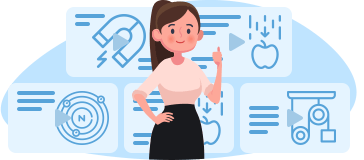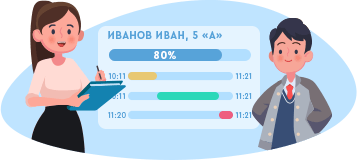Hello, guys! My name’s Tommy Wilson. Welcome to our grammar lessons!
Meet my best friends – Maddy, Kristie and Martin. Together we’ll try to make your learning very interesting and enjoyable.
At our lessons Kristie will ask you many questions.
Maddy is a very smart student.
You will practice the rules with Martin.
And I will be your guide to English grammar every lesson. So let’s get started!
In the lesson today we’ll revise Present, Past and Future Simple tenses:
- their formation and usage;
- time markers that help us to define them in the sentence,
and finally, we will practice the usage of these tenses in different situations.
Situation 1
Tommy: They say, an apple a day keeps the doctor away. Is that true, Maddy?
Maddy: Yes, it is.
Tommy: And what does an onion do, Maddy?
Maddy: Oh, no! I don’t like the smell! It keeps everyone away!
Look at the highlighted forms.
What tense is used in the Situation 1?
Right you are! The Present Simple Tense.
We form the Present Simple with the subject and the main verb. We usually add –s (–es) to the main verb if the subject is he, she, it.
E.g. They say, an apple a day keeps the doctor away.
Spelling rules:
· Most verbs take –s in the third person singular.
I read – he reads
· Verbs ending in –ss, -sh, -ch, -x and –o, take –es.
I kiss – he kisses, I brush – he brushes
I teach – he teaches, I fix – he fixes, I go – he goes
· Verbs ending in a consonant + y, drop the –y and take –ies.
I try – he tries, I fly – he flies
· Verbs ending in a vowel + y, simply take –s.
I buy – he buys
In the negative forms, we use the auxiliary verb don’t with I, you, we, they and doesn’t with he, she and it.
E.g. I don’t like the smell!
She doesn’t go out a lot on weekdays.
To build an interrogative sentence we put do/does before the subject.
E.g. Do they go on a summer holidays every August?

What does an onion do, Maddy?
We do not add an –s to the main verb when it appears with does/doesn’t.
Time markers used with the Present Simple include:
usually, always, sometimes, often, never, every day/week/month/year, etc., on Mondays/ Tuesdays, etc., in the morning/afternoon/evening, at night/the weekend, etc.
Present Simple is used:
· for permanent situations.
E.g. We live in a big house.
· for repeated or habitual actions in the present, especially with adverbs of frequency.
E.g. He often buys her flowers.
· for general truths and laws of nature.
E.g. The Sun sets in the west.
· for timetables or programmes.
E.g. The lesson starts at 10 o’clock.
Now it’s time to practice the rule with Martin.
Complete the sentences in order to make the statements true. Use don’t/doesn’t where necessary.
1. Rain falls from clouds.
2. Kangaroos don’t live in Germany.
3. Yoghurt doesn’t come from plants.
4. Water boils at 100 C.
5. Sheep eat grass.
6. Tomatoes don’t grow on trees.
7. Cows don’t lay eggs.
8. Plants need water to grow.
Situation 2

Mum: Was breakfast good, Tommy?
Tommy: Oh, yes! It was delicious! They were the best fried eggs and chips I have tasted!
Mum: Were they too spicy?
Tommy: No, they weren’t. Everything was perfect, Maddy!
Tommy (whispers to his dog): Good boy, Flipper!
What verb is used in its past simple forms in the dialogue?
The verb to be.
The past simple of the verb to be is was for I, he, she, it and were for we, you, they.
We form questions by putting was/were before the subject.
E.g. She was ill yesterday. Was she ill yesterday?
We form negations by putting not after was/were.
E.g. She was not ill yesterday. She wasn’t ill yesterday.

Teacher: Repeat after me, please. I walked, You walked, He walked…
Pupils: I walked … You walked … He walked…
Teacher: Faster, please.
Pupils: I ran … You ran … He ran…
What two groups are all the verbs in the English language divided into?
Regular and Irregular.
To use a regular verb in the Past Simple tense, we just add –d or –ed to the main verb.
Look: I walked … You walked … He walked…
Spelling rules:
· Verbs ending in –e take only –d. like – liked
· Verbs ending in a consonant + y, drop the –y and take –ied. study – studied
· Verbs ending in a vowel + y, simply take –ed. play – played, stay - stayed
· Verbs ending in one stressed vowel between two consonants double the last consonant and take –ed. stop – stopped
· Verbs ending in one l, double the l and take –ed. travel – travelled
To use an irregular verb in the Past Simple tense we use the list of irregular verbs.
run – ran, swim – swam, see – saw
And I can`t but mention, that you have to learn all the irregular verbs by heart!
We form questions by putting Did before the subject.
E.g. Did he plan his trip last week?
Did he go out yesterday?
We form negations with did not/didn’t.
E.g. He didn’t plan his trip last week.
He didn't go out yesterday?
Remember! In questions and negations, we take the base form of the verb.
We use the past simple:
· to talk about completed actions in the past.
E.g. Brian went to the swimming-pool last week.
· for actions which happened one after the other in the past.
E.g. First, they had lunch. Then they met some friends.
The past simple is used with the following time markers:
yesterday / then / when / How long ago…? / last night / month / year / Tuesday, etc.
three days / weeks, etc. ago, in 1965.
Look at the list. Write the sentences about Kristie with the past simple.
Now check yourselves.
1. She did do her homework.
2. She didn’t watch TV yesterday evening.
3. She tidied the living room on Saturday.
4. She made her bed in the morning.
5. She had a good weekend.
6. She didn’t go to school last week.
7. She turned on the computer.
Situation 3

Tommy: I’d like the vegetarian pizza, please. And I’m in a hurry. Will it be long?
Waiter: No, sir! It will be round as usual!
What tense do we use to talk about the future?
Great! Future Simple.
We form the future simple with will + base form. Will is used for all persons.
E.g. I will help you with your homework.
No, sir! It will be round as usual!
We form questions by putting Will before the subject.
E.g. Will Jake lend you his laptop?
We form negations with will not or won’t for short.
E.g. He will not / won’t pay the bill.
The Future Simple is used:
· for predictions about the future.
E.g. I think you’ll pass the test.
Life will be better fifty years from now.
· to talk about the actions which will happen in the future and we cannot control.
E.g. He will be sixteen next year.
· for promises / on-the-spot decisions / threats or warnings.
E.g. It’s cold. I’ll close the window.
I’ll write to you every day.
Stop talking or I’ll send you out.
Be quiet or the teacher will be angry.
· We use Will you…? to make a request.
E.g. Will you pass me some sugar?
· We use Shall I…? to make an offer.
E.g. Shall I help you clean the room?
· We use Shall we…? to make a suggestion.
E.g. Shall we go to the theatre tonight?
Time markers used with the future tense:
Tomorrow, tonight, soon, next week/month/year, in a week/month (in with time is translated через)
Look at the pictures. Fill in the gaps with will or shall and label the situations with the uses of the future tense.
Now check yourselves.
1. I will close the window. It’s very windy. (on-the-spot decision)
2. Don’t worry. I will buy you a new one. (promise)
3. Be careful! You will burn your hand. (warning)
4. Shall I do the washing up? (offer)
5. Will you help me? (request)
6. Don’t touch these wires! You’ll get hurt! (warning)
That`s all for today.
So we can claim that now we can:
· form the Present / Past and Future Simple tenses correctly;
· use these tenses in the needed situations;
Join us at our grammar lessons at videouroki.net and you’ll realize that grammar is interesting.

 Получите свидетельство
Получите свидетельство Вход
Вход




 0
0 4076
4076

